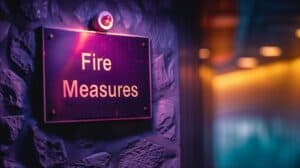In the heart of every thriving UK workplace lies a commitment to safety, with fire safety taking a pivotal role. Understanding and implementing fire safety protocols is not just about compliance; it’s about creating a culture of preparedness and responsibility. This comprehensive guide unveils 15 essential fire safety protocols, each designed to enhance your knowledge, ensure your safety, and empower you to act decisively in an emergency. From confidently navigating emergency exits to mastering firefighting equipment, our expert tips will prepare you for the unexpected, ensuring peace of mind for you and your colleagues.
1. Emergency Exit Mastery
Uncover the secrets to swift and safe evacuation, detailing not just the ‘where’ but the ‘how’ of emergency exits in UK workplaces.
2. Evacuation Plan Expertise
Step-by-step guidance on becoming fluent in your workplace’s evacuation strategy, focusing on the unique considerations of UK building regulations.
3. Fire Alarm Familiarity
This is a deep dive into understanding the nuances of fire alarm systems in the UK, from manual alarms to sophisticated detection technologies.
4. Effective Reporting Routines
How to promptly and effectively communicate fire emergencies, with insights into UK-specific reporting protocols.
5. Firefighting Equipment Proficiency
Learn how to use firefighting equipment like a pro, with a nod to UK standards and practices, from extinguishers to fire blankets.
6. Emergency Contacts Compilation
A curated list of essential UK emergency contacts, ensuring you’re never more than a moment away from expert assistance.
7. Calmness in Chaos
Strategies for maintaining composure in fire emergencies, fostering a calm and coordinated evacuation.
8. Assistance and Accessibility
How to assist colleagues and visitors with mobility concerns or other limitations, with attention to UK accessibility requirements.
9. Smoke Containment Tactics
Techniques for preventing the spread of smoke and fire, leveraging UK building design and safety features.
10. Smoke Navigation Skills
Learn the art of staying low and navigating smoke-filled environments safely with practical tips for various UK workplaces.
11. Elevator Etiquette
Why elevators are a no-go in fire situations and the safer alternatives provided by UK building standards.
12. Drill Participation and Preparedness
Regular participation in fire drills and safety training is essential, with a focus on UK best practices.
13. Hazard Identification Insights
Tips for spotting and reporting potential fire hazards in the workplace, adhering to UK health and safety regulations.
14. Adherence to Fire Safety Policies
Understanding and following your company’s fire safety policies, considering UK legal requirements.
15. Safe Re-entry Procedures
Navigating the process of safely re-entering a building post-evacuation, in line with UK safety assessments.

Every employee can contribute to a safer workplace by embracing these 15 fire safety protocols. Remember, knowledge is just the beginning; applying these protocols can genuinely make a difference in an emergency. Stay informed, stay prepared, and let’s work together to keep our workplaces safe.
Take your time with an emergency to discover you’re prepared. Take action now by reviewing your workplace’s fire safety procedures, participating in drills, and ensuring you and your colleagues can handle any situation confidently.










